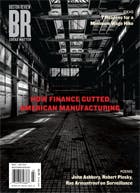A tour-de-force discussion about the role finance played/is playing in the “gutting” of U.S. manufacturing is at the Boston Review, an independent nonprofit that publishes thought provoking “public discussions of ideas that matter.” The March/April 2014 edition of the journal features the point/counterpoint as a cover story; it includes ten thought-provoking responses that deepen and expand upon the author’s thesis.
Because of the importance of this discussion to U.S. manufacturers and the impressive civility of the debaters, I’ve summarized the main points in this commentary. However, I encourage you to read the original.
Susan Berger, professor of political science at MIT, sparked the debate with the declaration: “Since the 1980s, financial market pressures have driven companies to hive off activities that sustained manufacturing.” Her assertion, she writes, derives from MIT research she led for the project, Production in the Innovation Economy, which aimed “to discover whether we really need manufacturing to gain the benefits of innovation: economic growth, new companies, new profits, and good new jobs….” (In a hurry? Read: 3 Questions: Suzanne Berger on converting innovation into growth)
As she was conducting the research, Berger notes, shareholders forced the break-up into two separate companies of one of her research’s subject companies: Timken Company (IW500/201), a $5 billion Ohio manufacturers of tapered bearings, power transmissions, gears, and specialty steel.
The shareholders argument for the split was that they wanted “’pure-play’ companies, focused on a single industrial activity.”
Investors would then be free to balance their portfolios by selecting businesses in industrial sectors with varying degrees of risk and sensitivity to different phases of economic cycles. A firm such as Timken—about one-third a steel company (a materials play) and about two-thirds a bearings and power transmission business (an industrial components play)—would lock investors into a mix that, Relational Investors claimed, leads to a discount on share price.
Ward “Tim” Timken, Jr., Timken’s chairman, and James Griffith, its CEO, who opposed the split, argued the following:
“…making both materials and products enabled them to bring to market higher-quality goods that met customers’ needs: for example, their ultra-large bearings for windmill towers, which measure two meters in diameter, weigh four tons, and have to stand up to extreme wind and temperature conditions. Controlling the entire value chain, they said, allowed them to fine-tune the attributes of the steel in order to make superior products.
Berger continues to make her case:
Timken’s story is not only about stock prices and product quality. Since the 1980s financial market pressures have transformed U.S. corporate structure itself. The system was once dominated by a few dozen very large, vertically integrated firms in which most or all of the functions needed to take a new idea about a product or a service to market—from R&D, design, manufacturing, testing, and logistics through sales and after-market services—were contained within the four walls of a single corporation. Now even the big firms are smaller, leaner, and centered on “core competencies,” with much of their production outsourced and overseas. Those pressures have driven companies such as Timken to hive off activities that involve heavy capital outlays, require large workforces, or promise less profitability in the short term.
The contribution of this decades-long trend to the rapid decline in American manufacturing has not been fully acknowledged. But understanding its role is essential to a revival of American manufacturing that will create jobs and promote long-term economic health.
The case Berger makes centers primarily on the downsizing of American manufacturing’s shrinking workforce, noting the 5.8 million U.S. manufacturing jobs that disappeared in the first decade of this century. She acknowledges other generally accepted explanations for the disappearance--productivity gains and increased trade with low-wage economies—but describes why they are not the primary drivers of manufacturing’s decline.
With regard to productivity gains, she notes that no direct correlation exists between rise in productivity gains and job losses. She also cites research that shows how national statistics overstate productivity gains.
With regard to trade and offshoring, she writes that the declines in manufacturing employment began well before the effects of globalization, which she pegs to the entry of China into the World Trade Organization in 2001.
Instead, she argues, the declines began in the 80s, when large, vertically integrated companies began spinning off all but those deemed “core competencies. “Under pressure from financial markets, they have shed activities that investors deemed peripheral—such as Timken’s steel,” she writes. Critical enablers, she notes, are increased digitization and the internet, which allowed the separation of functions across the globe. She writes:
"The breakup of vertically integrated corporations and their recomposition into globally linked value chains of designers, researchers, manufacturers, and distributors has had some enormous benefits both for the United States and for developing economies. It has meant lower costs for consumers, new pathways for building businesses, and a chance for poor countries to create new industries and raise incomes.
But the changes in corporate structures that brought about these new opportunities also left big holes in the American industrial ecosystem. These holes are market failures. Functions once performed by big companies are now carried out by no one."
The market failures caused when big companies focus on core competencies include a range of “semi-public goods, including workforce training, basic research, funding to bring innovation to scale and diffusion of new technologies to suppliers.”
After detailing each of the market failures, Berger recognizes initiatives in place to solve them. Still, she concludes that the solution lies in "creating real incentive for the more patient investment that growing production in America requires.”




